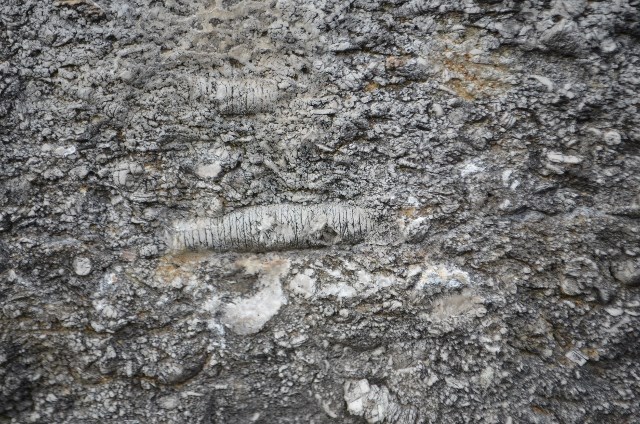I discovered this amazing phenomenon whilst on a lovely series in Llanfairpwllgwyngyllgogerychwyrndrobwllllantysiliogogogoch.
I was fascinated to see things in rocks, as you see, since attempting more Earthcaches, my eyes have been opened. The rock themselves are starting to be more of interest, as are...dead things...
What is a fossil?
Fossils are the preserved remains or traces of animals, plants, and other organisms from the remote past. The totality of fossils, both discovered and undiscovered, and their placement in fossiliferous (fossil-containing) rock formations and sedimentary layers (Strata) is known as the fossil record.
Typical fossils, such as shells and bones, are called 'body' fossils because they represent the actual remains of the animal
Trace fossils include burrows, footprints and bite marks and can therefore be used as indicators of fossil behaviour and are incredibly useful for palaeobiologists.
A fossil formed when an animal, plant, or other organism dies and is covered by sediment, its flesh decays and bones deteriorate due to chemical reactions, and a cavity remains below the ground surface are called mold fossils.
The rock that you are standing on is Carboniferous limestone laid down about 340 million years ago.
Limestone is a sedimentary rock composed mainly of calcium carbonate. Like most other sedimentary rocks, limestone is usually composed of grains. The grains in limestone are mostly skeletal fragments of marine organisms. Often Carboniferous limestone contains large numbers of fossils. Some of the most common fossil organisms found in Carboniferous limestone are brachiopods, crinoids and gastropods.
Brachiopods
Brachiopods are shellfish. There are a few brachiopod still surviving, but they used to be common. The name is derived from bracchium + poda (Latin) meaning 'arm foot'. A brachiopod attaches itself to a rock using a foot or pedicle. It has arms to catch its food.

Crinoids
Crinoids live in the sea. Their name is derived from krinoeides (Greek) which means 'like a lily'. They are also called sea lilies or feather-stars. Despite their name, they are animals.

Gastropods
Marine gastropods are animals that live in water. Their name is derived from gaster + poda (Greek) meaning stomach foot. If you watch a snail moving along on its single foot, you can understand the name. Gastropods are molluscs, like bivalves and cephalopods (ammonites, belemnites and nautiloids). Snail Gastropods include sea shellfish such as whelks.

- At the given coordinates, look at the obvious fossils. Using the information above, tell me whether the fossils are brachiopods, crinioids or gastropods.
- Are they body fossils, trace fossils or moulds?
- Do you think the rock containing the fossils is local to the area? Give reasons for your answers.
- What is the average size of the fossils?
- As an optional task, it would be nice to see a photograph of you or your GPSr close to GZ, but please don't upload any spoiler pics. I am not often sat at the PC, and to save you waiting possibly days for the thumbs up, feel free to log, with a pic to prove you were there, I love a cheesy smiley selfie. If there are major problems with the answers you send, I will let you know, otherwise take it as answers accepted :)
